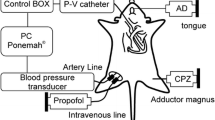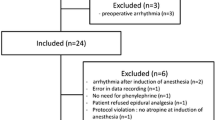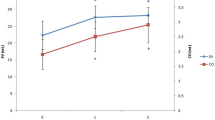Abstract
Calcitonin gene-related peptide (CGRP) produces vasodilation, hypotension, and tachycardia. We compared the hemodynamic effects of CGRP-induced hypotension with the effects of prostaglandin E1 (PGE1), which is currently used as a hypotensive agent during anesthesia. Eighteen mongrel dogs were anesthetized with pentobarbital (25 mg·kg−1), and 0.87% halothane in oxygen (1MAC). Measurements of hemodynamic variables were made before, during, and after induced hypotension. The mean arterial pressure (MAP) was lowered to 60 mmHg by the infusion of either CGRP (n=10) or PGE1 (n=8). This decrease in MAP was appoximately 50% of the baseline value. The CGRP- and PGE1-induced hypotension resulted in 61% and 51% maximum reductions (P<0.01, respectively) in systemic vascular resistance associated with a significant increase in stroke volume index; the two treatments, however produced inconsistent changes in cardiac index (CI). With CGRP, a maximum increase of 144% (P< 0.01) in CI was observed during induced hypotension. In contrast, PGE1-induced hypotension caused no significant changes in CI throughout the observation period. Left ventricular maximum dP/dt decreased (P<0.01) during the hypotensive period with PGE1, whereas it remained un-changes during CGRP-induced hypotension. The different results for changes in CI and cardiac contractility during the CGRP- and PGE1-induced hypotension were probably due to differences in ventricular filling pressure. Hypotension induced by PGE1 was associated with a significant decrease in heart rate (HR), whereas CGRP did not affect HR. This study shows that both CGRP and PGE1 are effective in decreasing afterload and in inducing hypotension; the results suggest that CGRP is a useful vasodilator for inducing hypotension during halothane anesthesia.
Similar content being viewed by others
References
Fisher LA, Kikkawa DO, Rivier JE, Amara SG, Evans RM, Rosenfeld MG, Vale WW, Brown MR (1983) Stimulation of noradrenergic sympathetic outflow by calcitonin gene-related peptide. Nature 305:534–536
Marshall I, Al-Kazwini SJ, Roberts PM, Shepperson NB, Adams M, Craig RK (1986) Cardiovascular effects of human and rat CGRP compared in the rat and other species. Eur J Pharmacol 123:207–216
DiPette DJ, Schwarzenberger K, Kerr N, Holland OB (1987) Systemic and regional hemodynamic effects of calcitonin generelated peptide. Hypertens 9[Suppl III]:III142-III146
Franco-Cereceda A, Gennari C, Nami R, Agnusdei D, Pernow J, Lundberg JM, Fisher JA (1987) Cardiovascular effects of calcitonin gene-related peptides I and II in man. Circ Res 60:393–397
Gennari C, Fischer JA (1985) Cardiovascular action of calcitonin gene-related peptide in humans. Calcif Tissue Int 37:581–584
Wang BC, Bie P, Leadley Jr RJ, Goetz KL (1989) Cardiovascular effects of calcitonin gene-related peptide in conscious dogs. Am J Physiol 257 (Regulatory Integrative Comp Physiol 26): R726-R731
Brain SD, Williams TJ, Tippins JR, Morris HR, MacIntyre I (1985) Calcitonin gene-related peptide is a potent vasodilator. Nature 313:54–56
Struthers AD, Brown MJ, Macdonald DWR, Beacham JL, Stevenson JC, Morris HR, MacIntyre I (1986) Human calcitonin generelated peptide: A potent endogenous vasodilator in man. Clin Sci 70:389–393
Takeda S, Inada Y, Matsui K, Tomaru T (1996) Halothane anesthesia suppresses reflex tachycardia caused by CGRP in dogs. J Anesth 10:58–62
Hoka S, Yoshitake J, Dan K, Goto Y, Honda N, Morioka T, Muteki T, Okuda Y, Shigematsu A, Takasaki M, Totoki T, Yoshimura N (1993) Intra-operative blood pressure control by prostaglandin E1 in patients with hypertension and ischemic heart disease. J Anesth 7:173–183
Liang J, Hoka S, Okamoto H, Kawasaki T, Yoshitake J (1993) Changes in venous capacitance during prostaglandin E1-induced hypotension; Comparisons with trinitroglycerin. J Anesth 7:303–307
Weiner R, Kaley G (1969) Influence of prostaglandin E1 on the terminal vascular bed. Am J Physiol 217:563–566
Nakano J, McCurdy JR (1967) Cardiovascular effects of prostaglandin E1. J Pharmacol Exp Ther 156:538–547
Seagard JL, Hopp FA, Donegan JH, Kalbfleisch JH, Kampine JP (1982) Halothane and the carotid sinus reflex: Evidence for multiple sites of action. Anesthesiology 57:191–202
Lynch III C, Vogel S, Sperelakis N (1981) Halothane depression of myocardial slow action potentials. Anesthesiology 55:360–368.
Bergström S, Carlson LA, Ekelund L-G, Orö L (1965)Cardiovascular and metabolic response to infusion of prostaglandin E1 and to simultaneous infusions of noradrenaline and prostaglandin E1 in man. Acta Physiol Scand 64:332–339
Carlson LA, Orö L (1966) Effect of prostaglandin E1 on blood pressure and heart rate in the dog. Prostaglandin and related factors. Acta Physiol Scand 67:89–99
Goto F, Otani E, Kato S, Fujita T (1982) Prostaglandin E1 as a hypotensive drug general anaesthesia. Anaesthesia 37: 530–535
Abe K, Demizu A, Kamada K, Morimoto T, Sakaki T, Yoshiya I (1991) Local cerebral blood flow with prostaglandin E1 or trimethaphan during cerebral aneurysm clip ligation. Can J Anaesth 38:831–836
Abe K, Demizu A, Yoshiya I (1992) Effect of prostaglandin E1-induced hypotension on carbon dioxide reactivity and local cerebral blood flow after subarachnoid haemorrhage. Br J Anaesth 68:268–271
Hoka S, Sato M, Okamoto H, Arimura H, Yoshitake J (1992) Effects of prostaglandin E1 on left ventricular performance in dogs; Comparisons with trinitroglycerin and adenosine triphosphate. J Anesth 6:45–50
Boettcher DH, Zimpfer M, Vatner SF (1982) Phylogenesis of the Bainbrige reflex. Am J Physiol 242 (Regulatory Integrative Comp Physiol 11):R244-R246
Hintze TH, Kaley G (1984) Ventricular receptors activated following myocardial prostaglandin synthesis initiate reflex hypotension, reduction in heart rate, and redistribution of cardiac output in the dogs. Circ Res 54:239–247
Panzenbeck MJ, Tan W, Hajdu MA, Cornish KG, Zucker IH (1989) PGE2 and arachidonate inhibit the baroreflex in conscious dogs via cardiac receptors. Am J Physiol 256 (Heart Circ Physiol 25):H999-H1005
Hintze TH, Martin EG, Messina EJ, Kaley G (1979) Prostacyclin (PGI2) elicits reflex bradycardia in dogs: Evidence for vagal mediation. Proc Soc Exp Biol Med 162:96–100
Roux S, Latour JG, Thérou P, Clozel JP, Bourassa MG (1984) Prostaglandin E1 increases myocardial contractility in the conscious dog. Can J Physiol Pharmacol 62:1505–1510
Bloor BC, Fukunaga AF, Ma C, Flacke WE, Ritter J, Van Etten A, Olewine S (1985) Myocardial hemodynamics during induced hypotension: A comparison between sodium nitroprusside and adenosine triphosphate. Anesthesiology 63:517–525.
Author information
Authors and Affiliations
Additional information
This study was supported by a Grant-in-Aid (No 04807115) for Scientific Research (C) from the Ministry of Education, Science, Sports, and Culture, Japan
About this article
Cite this article
Takeda, S., Inada, Y., Matsui, K. et al. Comparative hemodynamic effects of hypotension induced by CGRP and PGE1 in dogs. J Anesth 10, 204–210 (1996). https://doi.org/10.1007/BF02471392
Received:
Accepted:
Issue Date:
DOI: https://doi.org/10.1007/BF02471392




